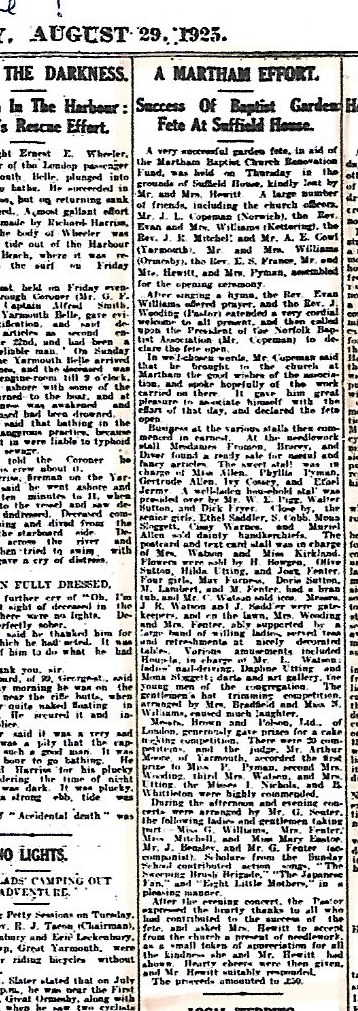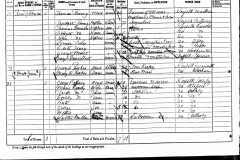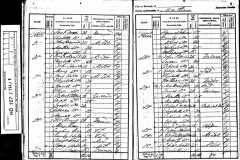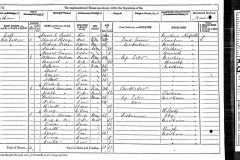Sutfield House, White Street, Martham

Sutfield House stands on the west side of White Street and is the only purpose-built Georgian home in Martham that remains occupied to this day. The earliest hint we get that a member of the Sutfield family probably lived there is from an advert that appeared in the Norfolk Chronicle on 24th December 1790 that is shown here:

The William Sutfield in question lived from 1712 to 1796 and was the last member of several generations of Sutfields that were very successful farmers and landowners who lived in Martham. You can read more about him and the Sutfields in general by clicking on their names (link awaited).
The advert shows he was selling his interests in a house and land at Martham and another house in King Street, Great Yarmouth. It indicates that he was living near The Green, which was probably Sutfield House, as this would have been commensurate with his status as a landowning yeoman farmer. It is quite likely that he gave his name to the house. The interesting thing is that he does not seem to have owned it because the advert refers to a lease he held that was to expire at Michaelmas 1792. The auction sale took place during June 1791. We do not know the outcome by but William was 80 by then and obviously wanted to retire and sold most of his estate and lived out his days on the proceeds.
So, if the Sutfields rented the house, who were the owners? The most likely owners were the Rising family, who we shall come to see had a long association with it and were one of the few families in the area that had the means to build it. The house was almost certainly built by Thomas Sutfield Rising (1774-1855). So during these years, something seems to have connected all three to earlier Sutfield generations. If you know of a connection between the families, please let me know.
The earliest map showing the existence of buildings on the site is the one that accompanies the 1812 Martham Inclosure Award shown on the right. Inclosure Awards are legal documents recording the ownership and distribution of land. They set out to show ownership of land by individuals, churches, schools and charities, as well as roads, rights of way, drainage and land boundaries. They were not particularly drawn up to identify properties but the accompanying map does seem to show buildings of some sort, perhaps barns. Unfortunately, the plot is not numbered but the 1807 Act that gave rise to the whole process required landowners to make claims which were then considered by Commissioners. The Rising family made several claims and Thomas S Rising claimed ownership of 14 acres which included two inclosures he owned in 1807. The plot covering the land where Sutfield House is today can be seen on the map outlined in pink.

1834 Register of Electors – see appendix SU01
Thomas Sutfield Rising was listed in this voters list as a freehold owner and occupier resident at Martham. It does not give his address but there is no reason to believe it was anywhere other than at Sutfield House.
1841 Census – see appendix SU02
The 1841 census lists White Street, as it was known at the time, as Highgate Street. Thomas Sutfield Rising (b1774) lived at what would have been Sutfield House (although it is not named as such). The census says he was a farmer. He had a live-in housekeeper, called Mary Thain, plus two female and two male servants. So, at this stage he had been associated with the land for over 34 years since the time of the Inclosure Award.
Thomas lived in the house at the time of the 1841 census and was also listed as the owner at the time of the 1842 Martham Tithe Award. To add to the mystery, we find that Thomas was not the only Rising to have the middle name Sutfield. He had a nephew, also called Thomas Sutfield Rising (1825-1899), who was the son of William & Elizabeth Rising. Neither of the young men ever married. The third was William James Sutfield Rising (1863-1918), who was the son of Benjamin & Sarah Rising, but he came much later and was not associated with the house.

The area covering Sutfield House in the 1842 Tithe Award is shown on its accompanying map on the left. This was drawn because the Tithe Commutation Act of 1836 required that payments of tithes in the form of farm produce should be replaced by money payments. Tithe was a tax, which was paid to the local church. Tithe maps generally show the boundaries of woods, fields, roads, waterways and buildings. This copy of the Norfolk map shows White Street towards the Village Green end and on the left Sutfield House as plot Nos. 343 & 343a being house, garden, land and pasture. The schedule that accompanies the map lists the plots as being owned and occupied by Thomas S Rising. Plot 343 was listed as consisting of one acre, two rods and 10 perches in area and his annual contribution to the Vicar and Church required him to pay 5s 41/2d per annum (about 27p in today’s money).
1845 White’s Directory – see appendix SU03
Thomas Sutfield Rising was listed in this directory as a ‘gentleman’ resident of Martham and the Chief Constable. It does not give his address but it is almost certainly at Sutfield House.
1850 Hunt & Co Directory – see appendix SU04
Again, Thomas was listed in this directory as the Chief Constable and again it does not give his address but was probably still Sutfield House.
1851
The census return for 1851 does not actually name Sutfield House but it is obvious from the order that this is where Thomas was living. Mary Thain was still there as his housekeeper and he was listed as being a farmer of 50 acres employing 3 labourers. He also had three servants living in.
By the time Thomas died in 1855 he had no children and his only remaining brother was George Rising (b1779) of Caister so either George or his son Benjamin inherited the house. George was already established as a farmer at Caister and so it seems that his son Benjamin, who married Harriot Gillett in 1860, moved into Sutfield House.
1861 – See appendix SU05.
Again, the census return does not actually name Sutfield House but working on the walking order of the census and surrounding properties it is clear that the nephew of Thomas called Benjamin William Rising & his wife Harriot, nee Gillett had moved in. Benjamin was raised in Caister and was the son of George Rising as shown above. In 1868 William Gillett (1813-1883), the brother of Harriot, was also living at Sutfield House according to the Harrolds Business Directory of that year. He was another Yeoman farmer and in 1861 farmed at West End Cottage (now known as Grange Farm, Cess).
1871, 1881 & 1891 – See media appendix SU06, SU07 & SU08.
The census returns for these years actually name the house and show that Benjamin and his wife raised their family there throughout this time. We get some idea of the status of the household in 1891 when Benjamin had a live-in valet called Jacob Allison. I have not found any other record for a Martham resident who has his own valet although Benjamin was 69 by this time and may not have been in the best of health.
The Ordnance Survey map below is from 1906 and clearly shows the Sutfield House drive, entrance and stables on the north side of the house.

1901 & 1911 – See appendix SU11 & SU12.
Benjamin had died on 20th March 1897 but his widow, Harriot, was still living at Sutfield House throughout 1901 & 1911. In 1911 she was 83 and usefully filled in the census form saying that she had 5 children who were all alive before crossing the entry out because it was not applicable at the time. Her spinster sister Ann was also living with her as well as a nephew and servant. The 1911 return tells us that the house had 9 rooms excluding the hall, lobby, stairs, landing and any bathroom(s) or warehouse but should have included the kitchen.
1913 /1914 – Harriot died on 27th July 1913. Harriot and her sister, Anne, were the last of the Risings to consistently live in Martham and the death of Anne saw the end of the Rising family association with the village.
Sutfield House was subsequently sold at auction to Willian Henry DRAPER on 17th June 1914. The adverts shown below from the Yarmouth Independent newspaper concerning the sale give us a good idea of the size and status of the house and the extent of the estate as a whole.


1914 – The newspaper report on the right above published on 17th June 1914 makes it clear that the house was purchased by William Davey for £750 plus £3 17s 3d for fixtures and fittings. It is not clear whether William lived there or simply purchased it as an investment but we do know that by 1921 he lived with his wife and two daughters at 27 Nelson Road, Great Yarmouth. He was 60 and a solicitor’s manager working for Burton & Son, Solicitors of Great Yarmouth.
1920 – 1921
The electoral register of 1920 shows that Benjamin & Ann Fathers were the occupiers of Sutfield House. He was the Head Teacher at the first Board School from 3rd January 1902 to 30th September 1921. They were also listed as living there in the June 1921 census but by September/October 1921 Benjamin was preparing to move to Market Deeping, Lincolnshire. We know this from two adverts in the Yarmouth Independent newspaper dated 2nd July 1921 and 8th October 1921. The first advertised the sale of Sutfield House with possession available from 11th October 2021. The second was for the sale of his furniture and outdoor effects on 10th October 1921. Neither say he owned the house so he was probably just a tenant.


1925


There is evidence of another change in ownership by 1925 when on 9th August that year an article appeared in the Independent & The Journal newspaper about a fete held at the house in aid of the Baptist Church renovation fund. The owners allowing the fete to take place were Mr & Mrs Hewitt. A copy of the rather long article is shown below with a transcription of the first part of it.

Independent & The Journal
Saturday 29th August 1925
A MARTHAM EFFORT
Success of Baptist Garden Fete at Sutfield House
A very successful garden fete, in aid of the Baptist Church renovation fund, was held on Thursday in the grounds of Sutfield House, kindly lent by Mr. & Mrs. Hewitt. A large number of friends including the Church officers Mr. J L Copeman (Norwich), the Reverend Evans and Mrs. Williams (Kettering), the Rev J R Mitchel and Mr. A E Cowl (Great Yarmouth), Mr. & Mrs. Williams (Ormesby), the Rev E S Fraser, Mr. & Mrs. Hewitt and Mrs. Pyman assembled for the opening ceremony.
After singing a hymn the Rev Evan Williams offered pray and the Rev J Wooding (Pastor) extended a very cordial welcome to all present and then called upon the President of the Norfolk Baptist Association (Mr. Copeman) to declare the fete open.
In well chosen words Mr. Copeman said that he brought to the church at Martham the good wishes of the Association and spoke hopefully of the work carried out there. It gave him great pleasure to associate himself with the effort of that day and declared the fete open.
There followed a long list of contributors and participants to the fete stalls plus afternoon and evening entertainment.

Relatives of Mr & Mrs Hewitt tell me that the couple were still living there up to 1933 and were market gardeners. Jimmy Hewitt also grew soft fruit including strawberries and the photograph on the left shows one of the strawberry crates he used for sending them to market using the local railway station.
Post 1937
There is an indication that the house had changed hands by 1937 when Kelly’s Directory for that year listed George Arthur Bailey as living there. He was the market gardener and nursery man who had just about all of what is now the Bell Meadow estate covered in greenhouses that were just outside the back door of Sutfield House.
In 1939 a Register of population was compiled in preparation for the impending second world war and that listed George Bailey and his family living at the house. George was married to Lilian Dorothy, nee Howes which is a surname we have already seen as being previously connect to the Risings so it may be that we have come full circle to where we started.
The two aerial photos below are modern ones of Sutfield House amongst the trees with the Village Hall in the foreground, taken in 2015.


Below is a gallery of the appendices. Hover over any image to see its description. Click on any image to zoom in and then scroll through as many as you wish.










